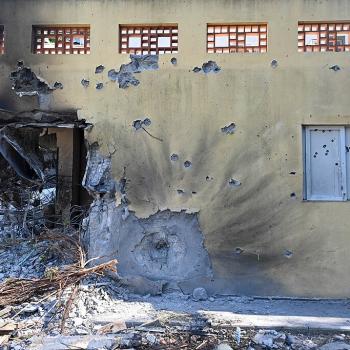Parshat Hukat Num 19:1-22:1
In the beginning of the second aliyah of Parshat Hukat, following the laws of the Parah Adumah – the red heifer – we read of the prophet Miriam’s death near the end of Israel’s desert journey. The Torah is characteristically concise:
“The whole group of Israelites arrived at the wilderness of Zin in the first month, and the people stayed at Kadesh. Miriam died there and was buried there. And the group was without water, and they gathered against Moshe and Aharon.” (Num 20:1-2)
What follows is a familiar scene: the Israelites regret not having been killed off by G-d earlier. They complain to their leaders (now less one) for leading them into this wasteland, where they will surely die. They lament a lack of water to drink and the fragrant fruits they remembered (or, at the very least: longed for the familiarity of) from their days of slavery in Egypt. Yet this instance of complaint differs from those which came before precisely because it is directly connected to the death of the prophet Miriam. Pulling from the Talmud, Rashi teaches:
ולא היה מים לעדה. מִכָּאן שֶׁכָּל אַרְבָּעִים שָׁנָה הָיָה לָהֶם הַבְּאֵר בִּזְכוּת מִרְיָם ([תענית ט’
And the group was without water: From this, we know that for the previous 40 years [in the desert], Israel had their well of drinking water because of Miriam’s merits (Rashi on Num 20:2, BT Taanit 9a).
Curiously, we do not see here a mention of why or from what Miriam died. The brevity is disappointing, but it also makes space for a sharper focus on the collective loss and communal impact which her death brought, rather than the cause. It is easy to envision the well not only as a measure of Miriam’s merits, but also as a reflection of the community’s overall well-being. Lacking water, we expend so much energy merely surviving that it becomes harder to see ourselves and one another clearly. Perhaps it is no wonder that, in a moment of collective crisis following the death of an honored leader, the Israelites’ wells ran dry.
This year, while studying the laws of aveilut (mourning) in Rabbinical School, I came across one practice which piqued my interest.
מנהג לשפוך כל המים שאובים שבשכונת המת:
It is a custom to pour out all drawn water in the neighborhood of a corpse (Shulhan Aruch, Yoreh Deah, 339:5).
In earlier ages, people kept containers of water drawn from wells at their homes for general use. While the Shulhan Aruch offers no clear explanation for this custom, Kol Bo (a 15th century legal text of uncertain origin) offers the following gloss:
ומנהג לשפוך כל מים שאובין שבשכונתו. וטעם המנהג לסימן שידעו הכל שיש בו מקרה מות ולא יהיה מודיע בפה… ויש אומרים כי הטעם לפי שמלאך המות מפיל במים טפת דם המות.
“And custom is to pour out the drawn water in the neighborhood of a corpse: The reason for this custom is to signify and make known to others that a death occurred here without needing to make it known verbally… And some say the reason for this custom is because the Angel of Death dips in water drops of blood of the deceased” (Kol Bo 114:49)
Perhaps this custom was a way to communicate indirectly about death – if something as valuable as water is dumped onto the ground, surely it is a sign something bad has happened – just as the Israelites’ water sources dried up following Miriam’s death. Alternatively, there is a possibility that this practice evolved from a superstition around wanting to prevent the Angel of Death from further afflicting the community environment: this reflects a Jewish explanation for a folk practice apparently prevalent in many other cultures. It could also be that this custom is similar to that of covering mirrors in a home during the week of shivah: just as a mirror could reflect the soul of a person, so too could the surface of a vessel of water.
Yet one earlier source connects this practice directly to the death of Miriam. The Sefer Tashbetz Katan is a 13th century collection of teachings of the Maharam of Rothenberg, as collected by his student Rabbi Shimshon ben Tzadok. According to this interpretation, the merit of Miriam is invoked upon a death by pouring out water to demonstrate that any person – and perhaps this person – is as meritorious as she.
ספר תשבץ קטן (ר’ שמשון בן צדוק)
מה שאנו שופכין המים לחוץ. כשמתה מרים הנביאה פסק הבאר דכתיב: ,”ולא היה מים לעדה שבזכותה היה הבאר הולך. ואנו מרמזין לזה שהוא גדול ובדין הוא שיפסקו המים בשבילו.
And the fact that we spill the water [that was in the presence of the dead man] outside [after the death] is because when Miriam died the well ceased. For it is written: “And there was no water for the congregation” (Num 20:2) since it was for her merit that the well traveled [with the Israelites]. We allude to it to show that he [the deceased] is a great man and he is worthy that water would cease on his behalf.
This custom strikes upon something deeper: the moment of death often feels shockingly brief, even when it is anticipated. Grief, by contrast, ebbs and flows over no set timeline. Pouring out a vessel of water takes only an instant, and there is no way to put it back into its container as the contents trickle and spread, sinking into their surroundings. Unlike water, however, the memory of a person does not evaporate once they are no longer alive. Memories linger and sustain, making themselves known in unexpected places, just as water does, even in a desert environment. Perhaps this is what it means for memories to be a blessing.
Alyssa Coffey (she/her) is a rabbinical student at Hebrew College, where she also serves as Editor of the 70 Faces of Torah blog. Prior to rabbinical school, she studied religion and history at Hampshire College, worked at a Jewish social service organization in Chicago, and spent two years studying in Jerusalem at Pardes. When not learning Torah, Alyssa is often knitting, spinning yarn, or solving puzzles.















